
Gay Merrill Gross is an expert in origami and the related skill of napkin folding. She is the author of Origami: The Art of Paperfolding, The Art of Napkin Folding, Folding Napkins, Napkin Folds for Special Occasions and three introductory books on origami. She lives in New York City.
| Introduction | p. 6 |
| Materials and Techniques | p. 8 |
| Greeting Cards | p. 18 |
| Envelopes and Letterfolds | p. 32 |
| Models for Cards | p. 42 |
| Modular Decorations | p. 86 |
| Tatos and Paper Pockets | p. 106 |
| Folded Cards | p. 122 |
| Picture Index and Resources | p. 140 |
| Acknowledgments | p. 144 |
| Table of Contents provided by Ingram. All Rights Reserved. |
The New copy of this book will include any supplemental materials advertised. Please check the title of the book to determine if it should include any access cards, study guides, lab manuals, CDs, etc.
The Used, Rental and eBook copies of this book are not guaranteed to include any supplemental materials. Typically, only the book itself is included. This is true even if the title states it includes any access cards, study guides, lab manuals, CDs, etc.